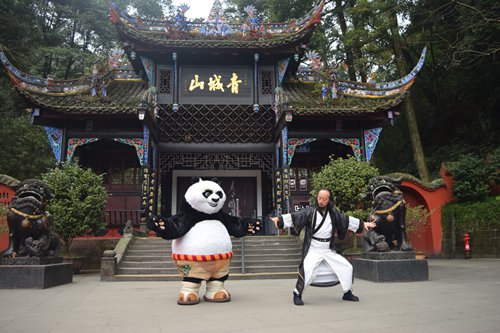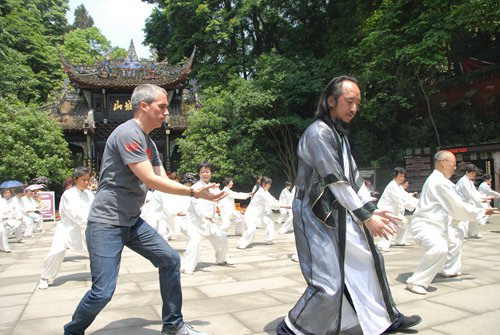
Liu Suibin shows Kung Fu Panda's Po some Qingcheng Tai Chi moves at the entrance to Mount Qingcheng in Southwest China's Sichuan Province in 2011. (Photo/Courtesy of Liu Suibin)

Inset: Raymond Zibach (left) practices tai chi with Liu Suibin in 2011. (Photo/Courtesy of Liu Suibin)
The basis for the mountains where Po from DreamWorks' Kung Fu Panda practices martial arts, Mount Qingcheng, has become a tourist hot spot for foreigners looking to explore the culture behind yin-yang and tai chi.
According to employees working at Mount Qingcheng in Southwest China's Sichuan Province, the number of foreign visitors began picking up over the past few days in advance of the spring peak season. According to a people.cn report from 2015, data from the Mount Qingcheng tourism bureau shows that the site witnessed a significant rise in the number of foreign visitors in 2014.
Located in Dujiangyan, a city 36 kilometers west of Chengdu, capital of Southwest China's Sichuan Province, the green-clad site featuring magnificent mountain views was included on the UNESCO World Heritage List in 2000 along with the Dujiangyan Irrigation System. Numbering among the four great mountains in Taoism, Mount Qingcheng has been a major center where Taoist philosophy has flourished for thousands of years.
Religious and philosophical center
At the very top of the mountain one can find several Taoist temples, where Taoist practitioners prayed to their gods by burning incense.
For some foreign visitors, Taoism is a mysterious school of thought represented by the famous black-and-white symbol of yin-yang and "secrets about health management," Pascal, a French visitor to the mountain, told the Global Times on Saturday.
"It is incredible. I am here to explore more," he said.
According to one of the Taoists walking up the long stone steps to the top of the mountain, while there are plenty of foreigners coming to the temple to learn more about Taoism, there are no foreign members of the temples just yet.
Taoism remains a mystery for even many Chinese today, as their impressions of the religion often stem from martial arts novels where Taoist masters, or daoshi, have superhuman abilities to tell fortunes or utilize qinggong, a martial arts skill that allows them to make great leaps through the air.
"Real Taoist culture is definitely different from what people read in novels," said Liu Suibin, council member of the Taoism Association of Sichuan Province and also head of the Qingcheng martial arts school, which is famous for its tai chi practice.
"In 2004, [famous martial arts novelist] Louis Cha visited Mount Qingcheng and apologized to the Qingcheng sect, saying that he didn't know enough about our martial arts back when he was writing about them in his novels."
"The public perception of so-called fortunetelling actually comes from our studies of the I Ching [Book of Changes], which is actually a Confucian classic. But since Taoists are keen to study about methods to improve health and even to prolong life, we also study it to learn more about these aspects," Liu told the Global Times.
Land of kung fu
According to Liu, he currently has more than 100,000 foreign students around the globe who practice Qingcheng martial arts. From political figures to beauty pageants queens, these foreign disciples, or waiguo dizi, include people from all walks of life such as the Miss Sierra Leone winner Mariatu Kargbo and a 34-year-old Canadian, known by his Chinese name Ke Danian, who won gold at the Chengdu Traditional Martial Arts Competition in 2009.
"It's more than just tai chi," Liu said. "In my class with managers from the world's top 500 companies, I teach them to explore Taoist philosophy and the wisdom behind these tai chi moves so they can improve their businesses and family life."
Qingcheng Tai Chi has also made a name for itself in Hollywood. The school's marital arts moves are used by Po the panda in Kung Fu Panda 2 in the scene where he confronts the evil Lord Shen. Posters for the film can be seen at the parking lot by the entrance to the mountain.
"The production team came to Mount Qingcheng for the first time in 2008 to carry out research for the film. They asked me to perform some Qingcheng Tai Chi for them," said Liu. "They then broke down one of my moves into 18 smaller moves and combined them into the moves Po uses to beat Lord Shen."
"The martial arts moves for Lord Shen came from one of my students, Pi Yongqiang," he noted.
According to Chinese media reports, Kung Fu Panada production designer Raymond Zibach expressed his gratitude toward "Master Liu" when he revisited Mount Qingcheng in 2011 and again in 2016 as part of promotional tours for the second and third films in the Kung Fu Panda franchise.
"He [Zibach] said in media reports that he incorporated into the films a lot of what he learned from me," Liu said.
Triple threat
Pandas are another of the city's attractions that have helped attract more foreign tourists to the region.
"Well, actually, my top priority is to see the pandas," a US tourist named Sarah told the Global Times Saturday.
"The mountain is not far from the panda park, so I just dropped by. I should say it was worth it, because it's really beautiful here."
The idea of combining pandas and the region's mountain views has already proved a successful formula, as Kung Fu Panda 3 raked in about $300 million around the globe in 2016.
"It's true that after the Kung Fu Panda franchise began more foreigners came visit the site," said Liu. "Following the Taoist culture of Mount Qingcheng and the water culture of the Dujiangyan Irrigation System, the city is now embracing the panda culture. We now have two panda parks here."


















































